Charles E W Bean, Diaries, AWM38 3DRL 606/247/1 - 1917 - 1933 - Part 1
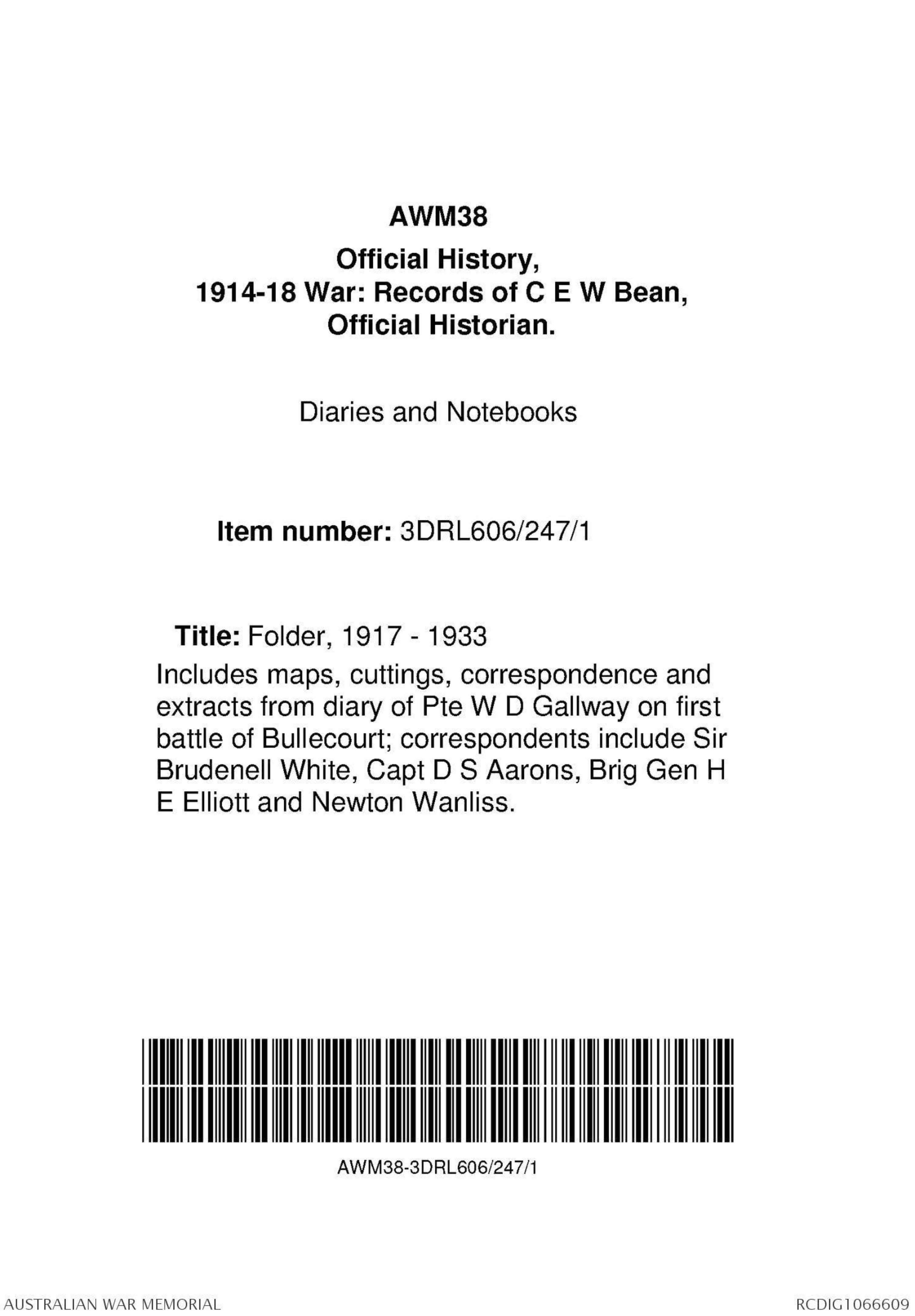
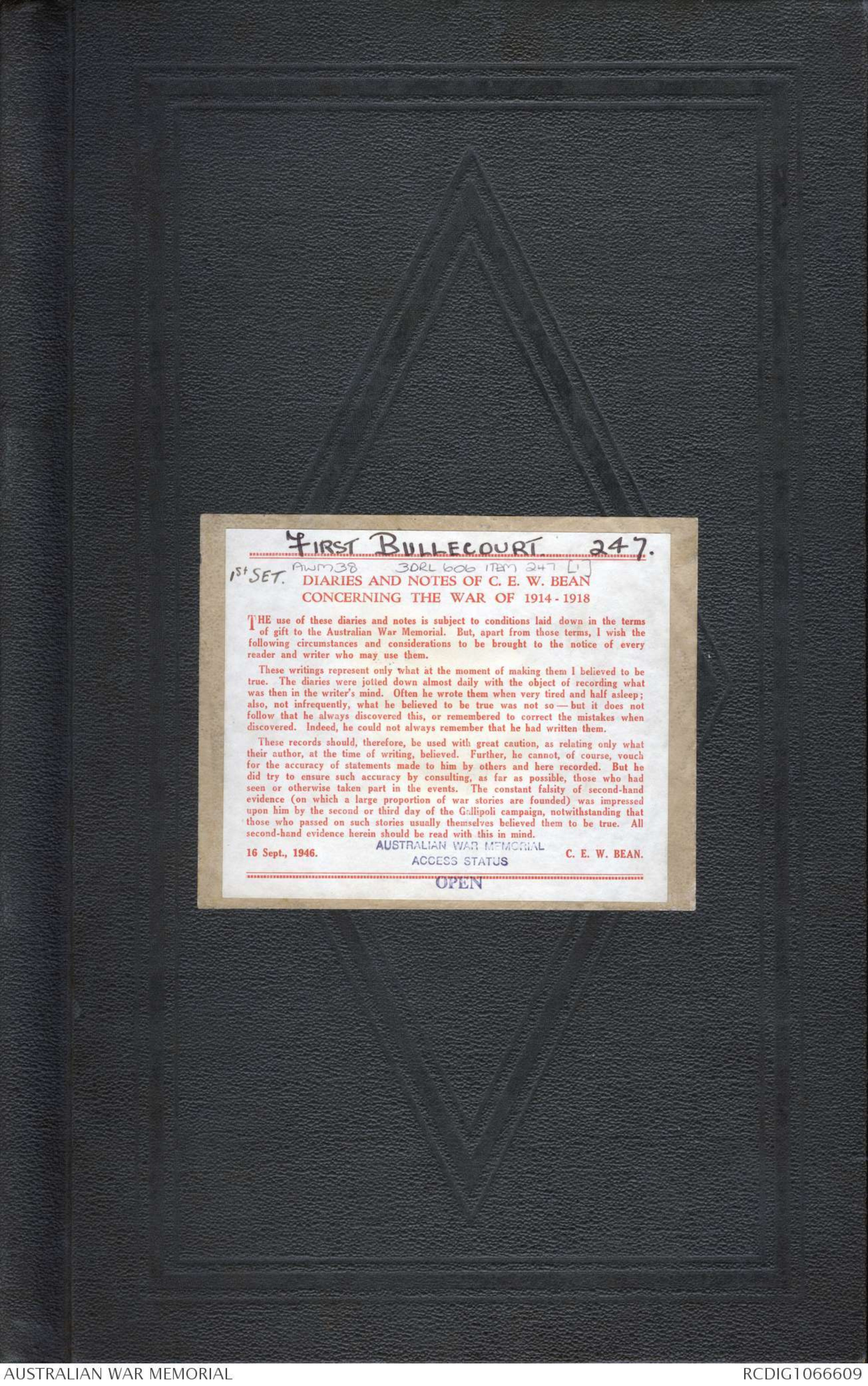
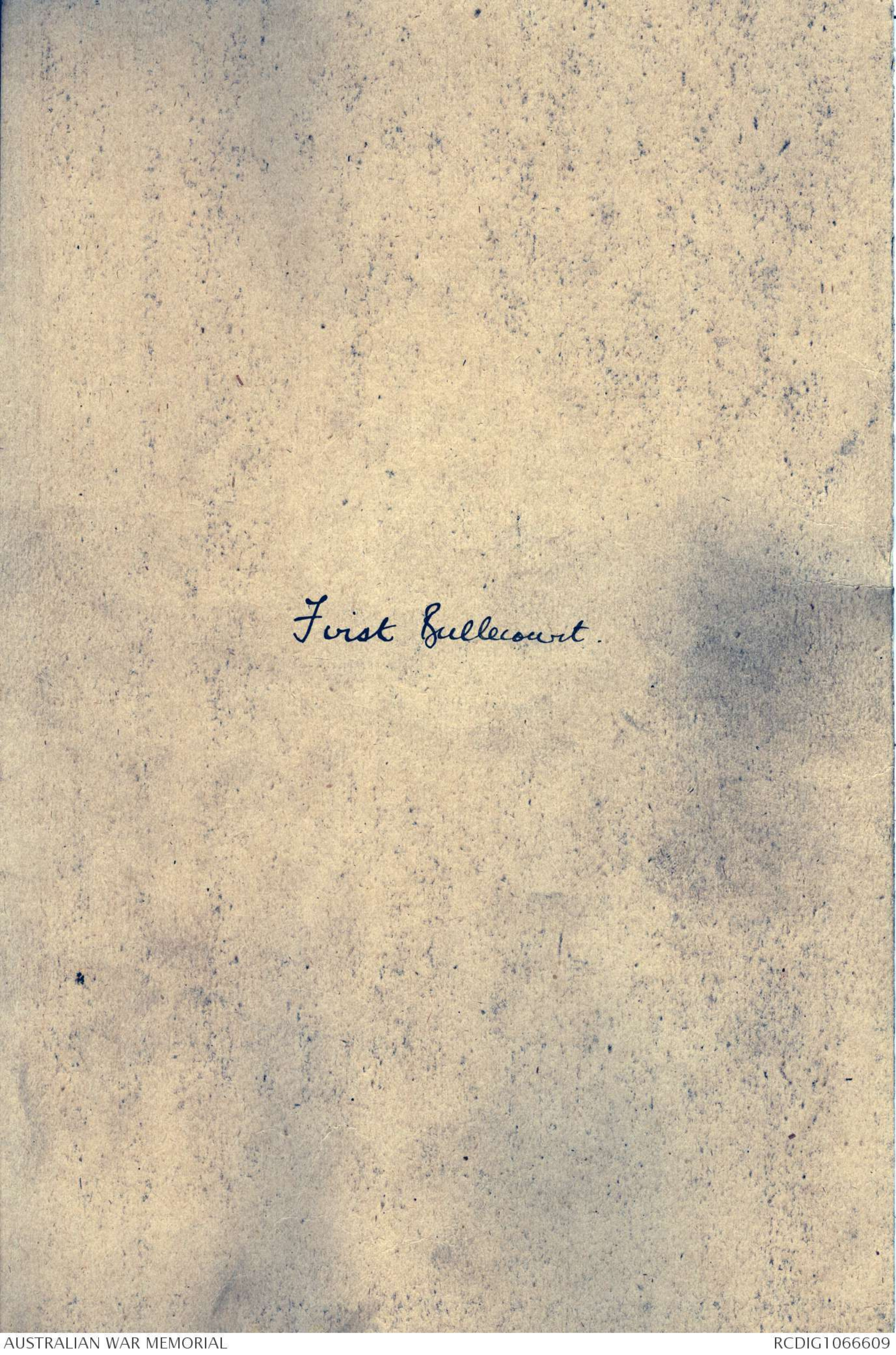
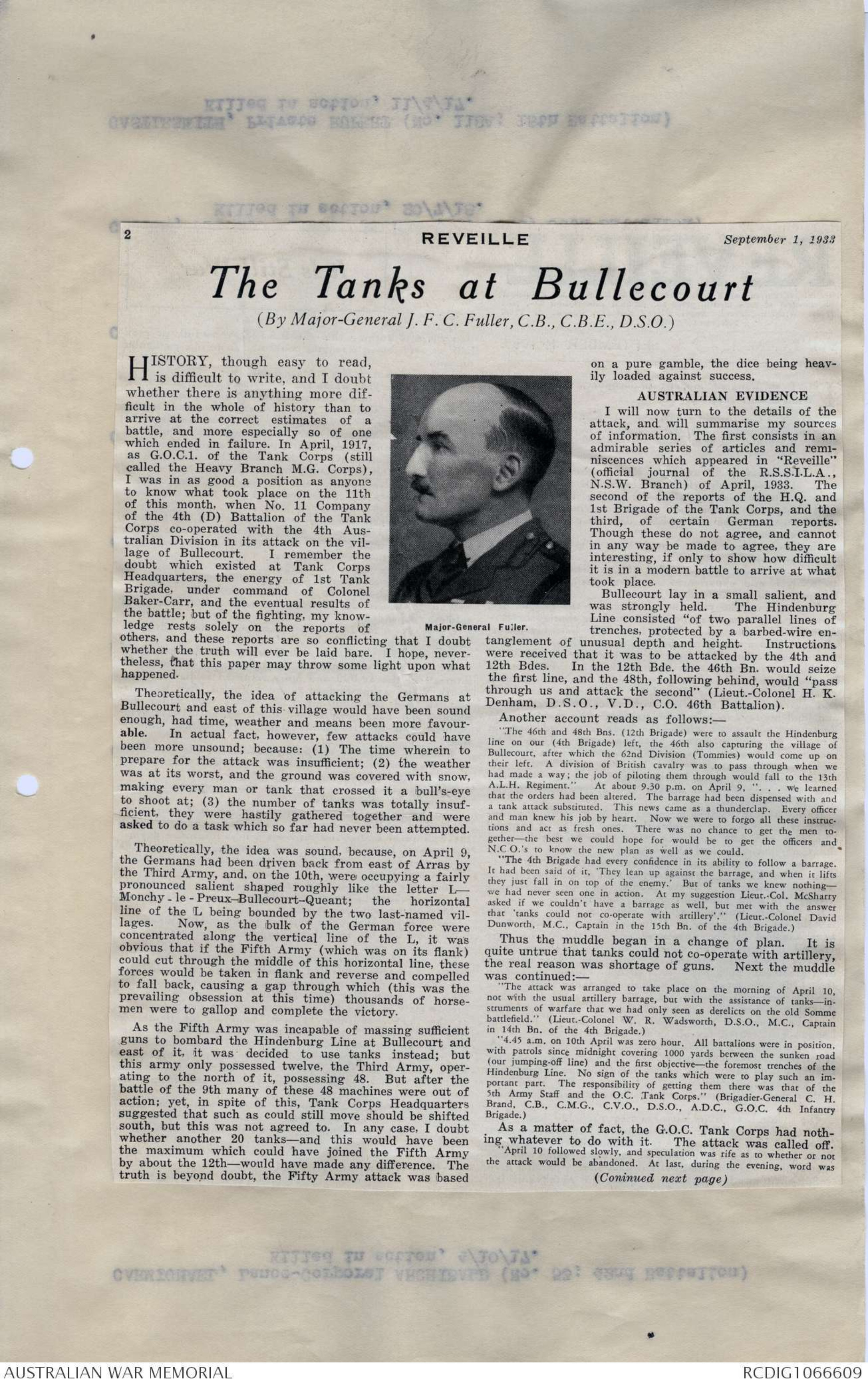
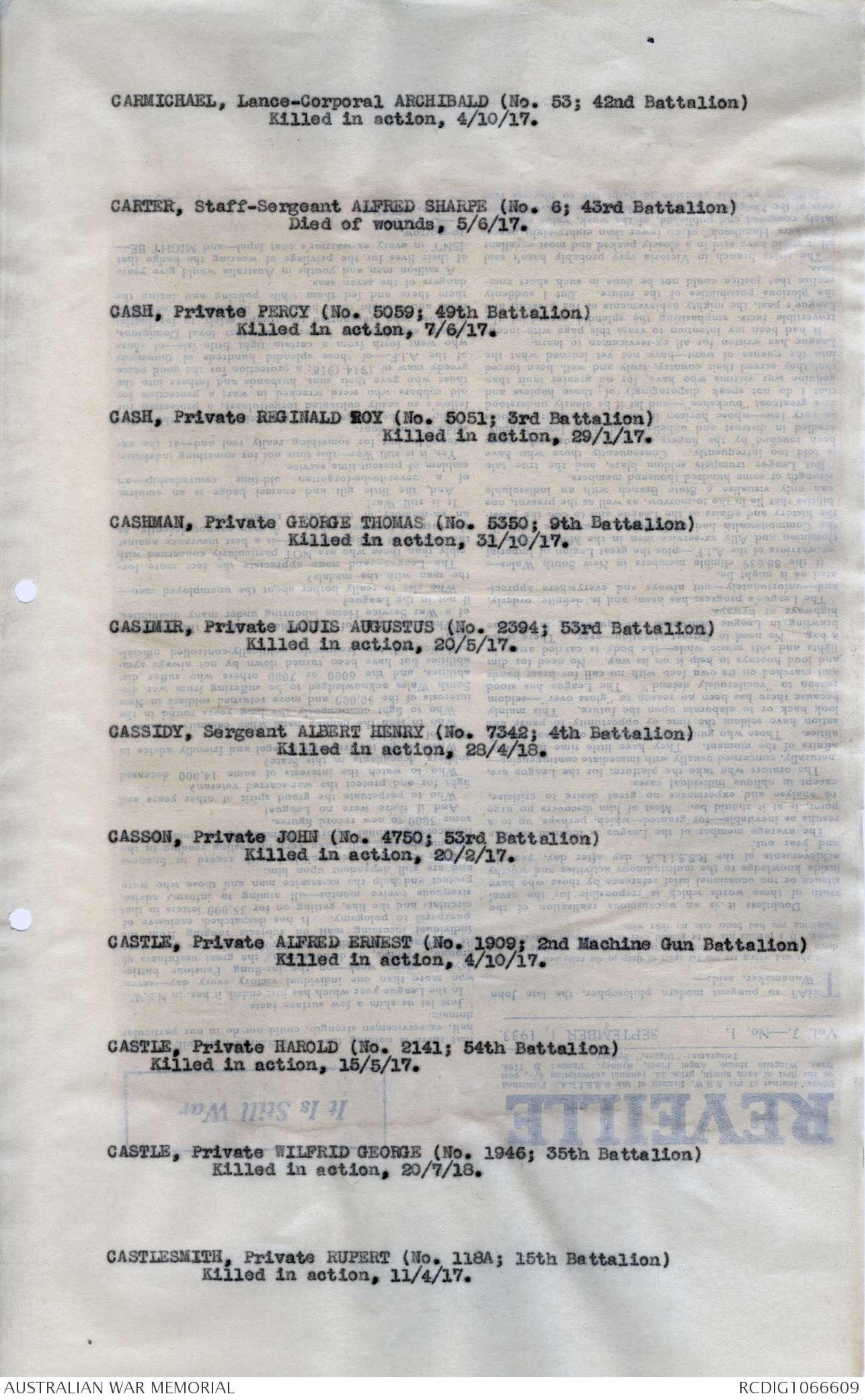
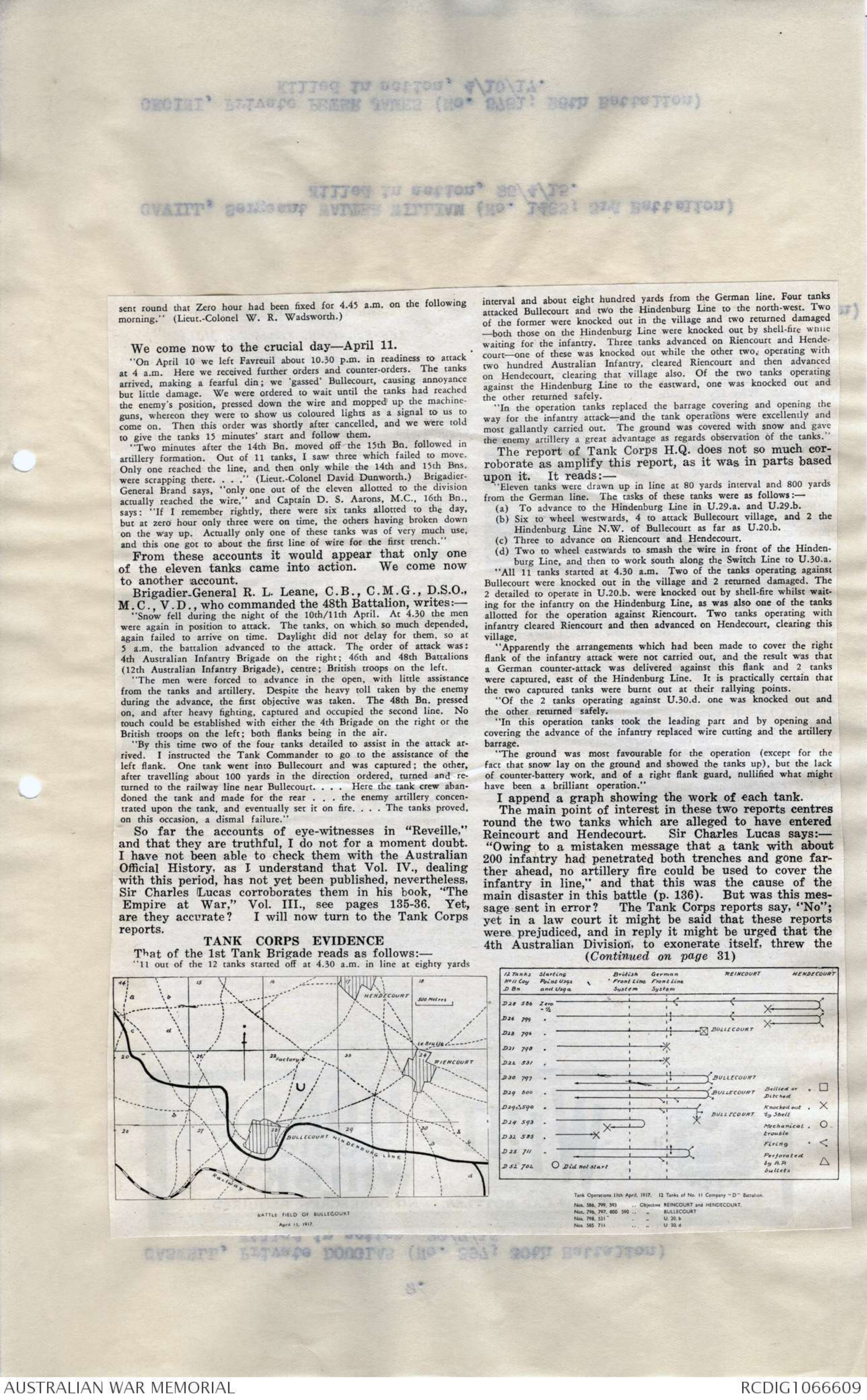

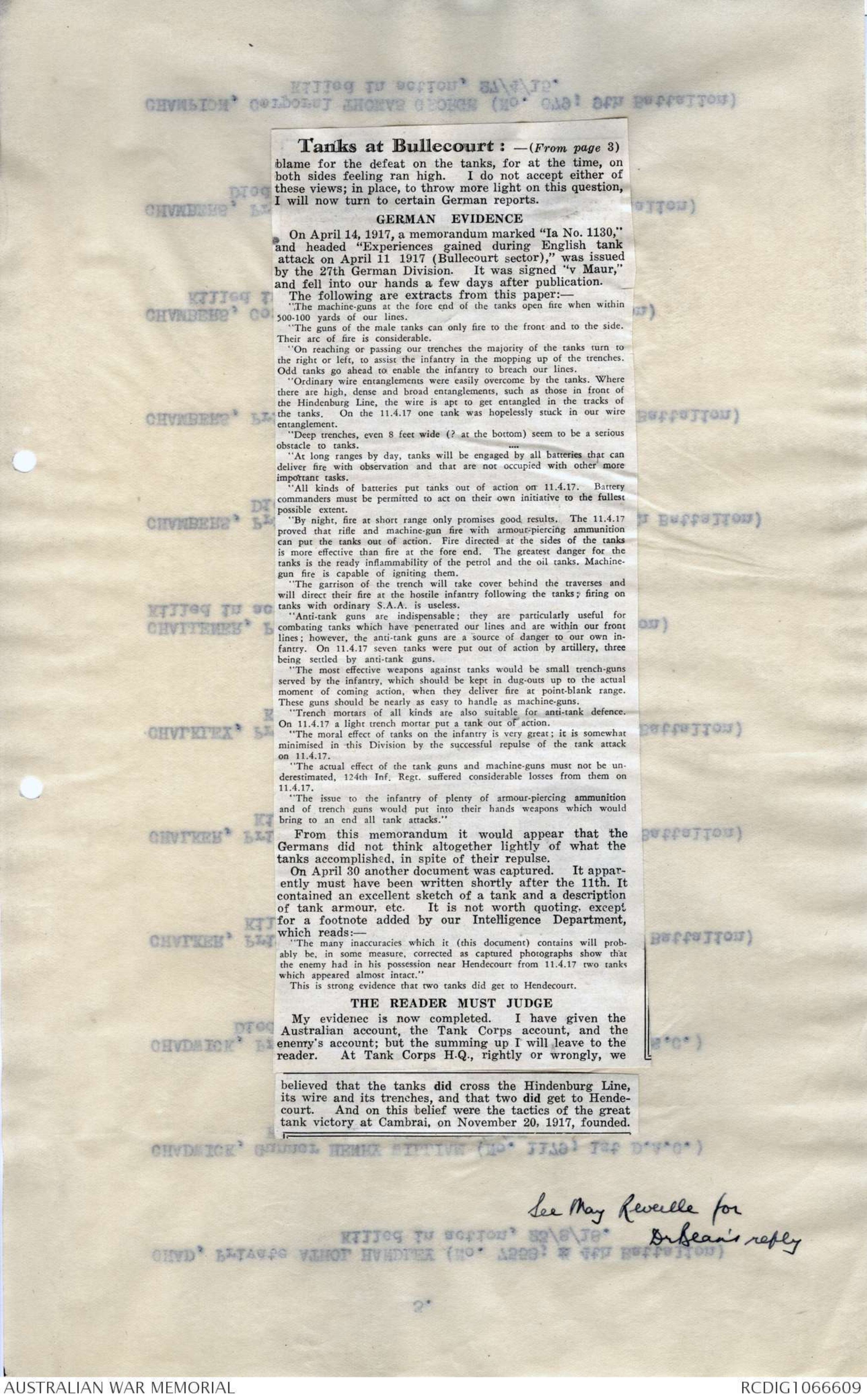
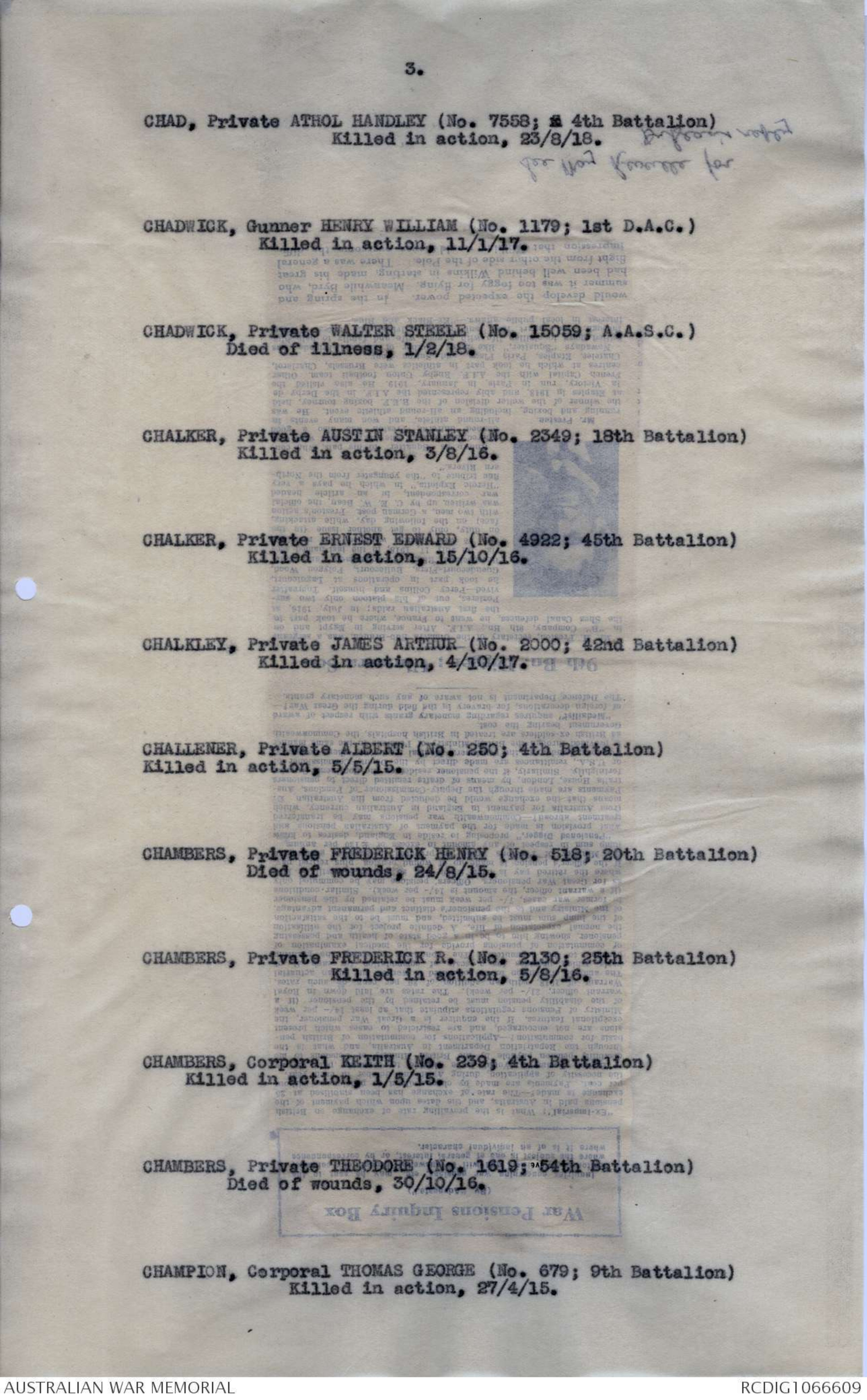

AWM38
Official History,
1914-18 War: Records of C E W Bean,
Official Historian.
Diaries and Notebooks
Item number: 3DRL606/247/1
Title: Folder, 1917 - 1933
Includes maps, cuttings, correspondence and
extracts from diary of Pte W D Gallway on first
battle of Bullecourt; correspondents include Sir
Brudenell White, Capt D S Aarons, Brig Gen H
E Elliott and Newton Wanliss.
AWM38-3DRL606/247/1
FIRST BULLECOURT. 247.
AWM38
3DRL 606 ITEM 247 [1]
1ST Set
DIARIES AND NOTES OF C. E. W. BEAN
CONCERNING THE WAR OF 1914 - 1918
THE use of these diaries and notes is subject to conditions laid down in the terms
of gift to the Australian War Memorial. But, apart from those terms, I wish the
following circumstances and considerations to be brought to the notice of every
reader and writer who may use them.
These writings represent only what at the moment of making them I believed to be
true. The diaries were jotted down almost daily with the object of recording what
was then in the writer's mind. Often he wrote them when very tired and half asleep;
also, not infrequently, what he believed to be true was not so - but it does not
follow that he always discovered this, or remembered to correct the mistakes when
discovered. Indeed, he could not always remember that he had written them.
These records should, therefore, be used with great caution, as relating only what
their author, at the time of writing, believed. Further, he cannot, of course, vouch
for the accuracy of statements made to him by others and here recorded. But he
did try to ensure such accuracy by consulting, as far as possible, those who had
seen or otherwise taken part in the events. The constant falsity of second-hand
evidence (on which a large proportion of war stories are founded) was impressed
upon him by the second or third day of the Gallipoli campaign, notwithstanding that
those who passed on such stories usually themselves believed them to be true. All
second-hand evidence herein should be read with this in mind.
16 Sept., 1946. C. E. W. BEAN.
AUSTRALIAN WAR MEMORIAL
ACCESS STATUS
OPEN
First Bullecourt
2 REVEILLE September 1, 1933
The Tanks at Bullecourt
(By Major-General J. F. C. Fuller, C.B, C.B.E., D.S.O.)
History, though easy to read,
is difficult to write, and I doubt
whether there is anything more difficult
in the whole of history than to
arrive at the correct estimates of a
battle, and more especially so of one
which ended in failure. In April, 1917,
as G.O.C.1. of the Tank Corps (still
called the Heavy Branch M.G. Corps),
I was in as good a position as anyone
to know what took place on the 11th
of this month, when No. 11 Company
of the 4th (D) Battalion of the Tank
Corps co-operated with the 4th Australian
Division in its attach on the village
of Bullecourt. I remember the
doubt which existed at Tank Corps
Headquarters, the energy of 1st Tank
Brigade, under command of Colonel
Baker-Carr, and the eventual results of
the battle; but of the fighting, my knowledge
rests solely on the reports of
others, and these reports are so conflicting that I doubt
whether the truth will ever be laid bare. I hope, nevertheless,
that this paper may throw some light upon what
happened.
Theoretically, the idea of attacking the Germans at
Bullecourt and east of this village would have been sound
enough, had time, weather and means been more favourable.
In actual fact, however, few attacks could have
been more unsound; because: (1) The time wherein to
prepare for the attack was insufficient; (2) the weather
was at its worst, and the ground was covered with snow,
making every man or tank that crossed it a bull's-eye
to shoot at; (3) the number of tanks was totally insufficient,
they were hastily gathered together and were
asked to do a task which so far had never been attempted.
Theoretically, the idea was sound, because, on April 9,
the Germans had been driven back from east of Arras by
the Third Army, and, on the 10th, were occupying a fairly
pronounced salient shaped roughly like the letter L-
Monchy-le-Preux-Bullecourt-Queant; the horizontal
line of the L being bounded by the two last-named villages.
Now, as the bulk of the German force were
concentrated along the vertical line of the L, it was
obvious that if the Fifth Army (which was on its flank)
could cut through the middle of this horizontal line, these
forces would be taken in flank and reverse and compelled
to fall back, causing a gap through which (this was the
prevailing obsession at this time) thousands of horse-men
were to gallop and complete the victory.
As the Fifth Army was incapable of massing sufficient
guns to bombard the Hindenburg Line at Bullecourt and
east of it, it was decided to use tanks instead; but
this army only possessed twelve, the Third Army, operating
to the north of it, possessing 48. But after the
battle of the 9th many of these 48 machines were out of
action; yet, in spite of this, Tank Corps Headquarters
suggested that such as could still move should be shifted
south, but this was not agreed to. In any case, I doubt
whether another 20 tanks - and this would have been
the maximum which could have joined the Fifth Army
by about the 12th - would have made any difference. The
truth is beyond doubt, the Fifty Army attack was based
Major-General Fuller.
on a pure gamble, the dice being heavily
loaded against success.
AUSTRALIAN EVIDENCE
I will now turn to the details of the
attack, and will summarise my sources
of information. The first consists in an
admirable series of articles and reminiscences
which appeared in "Reveille"
(official journal of the R.S.S.I.L.A.,
N.S.W. Branch) of April, 1933. The
second of the reports of the H.Q. and
1st Brigade of the Tank Corps, and the
third, of certain German reports.
Though these do not agree, and cannot
in any way be made to agree, they are
interesting, if only to show how difficult
it is in a modern battle to arrive at what
took place.
Bullecourt lay in a small salient, and
was strongly held. The Hindenburg
Line consisted "of two parallel lines of
trenches, protected by a barbed-wire entanglement
of unusual depth and height. Instructions
were received that it was to be attacked by the 4th and
12th Bdes. In the 12th Bde. the 46th Bn. would seize
the first line, and the 48th, following behind, would "pass
through us and attack the second" (Lieut.-Colonel H. K.
Denham, D.S.O., V.D., C.O. 46th Battalion).
Another account reads as follows:-
"The 46th and 48th Bns. (12th Brigade) were to assault the Hindenburg
line on our (4th Brigade) left, the 46th also capturing the village of
Bullecourt, after which the 62nd Division (Tommies) would come up on
their left. A division of British cavalry was to pass through when we
had made a way; the job piloting them through would fall to the 13th
A.L.H. Regiment." At about 9.30 p.m. on April 9, " . . . we learned
that the orders had been altered. The barrage had been dispensed with and
a tank attack substituted. This news came as a thunderclap. Every officer
and man knew his job by heart. Now we were to forgo all these instructions
and act as fresh ones. There was no chance to get the men together
- the best we could hope for would be to get the officers and
N.C.O.'s to know the new plan as well as we could.
"The 4th Brigade had every confidence in its ability to follow a barrage.
It had been said of it, 'They lean up against the barrage, and when it lifts
they just fall in on top of the enemy.' But of tanks we knew nothing -
we had never seen one in action. At my suggestion Lieut.Col. McSharry
asked if we couldn't have a barrage as well, but met with the answer
that 'tanks could not co-operate with artillery'." (Lieut. Colonel David
Dunworth, M.C., Captain in the 15th Bn. of the 4th Brigade.)
Thus the muddle began in a change of plan. It is
quite untrue that tanks could not co-operate with artillery,
the real reason was shortage of guns. Next the muddle
was continued:-
"The attack was arranged to take place on the morning of April 10,
not with the usual artillery barrage, but with the assistance of tanks - instruments
of warfare that we had only seen as derelicts on the old Somme
battlefield." (Lieut.-Colonel W. R. Wadsworth, D.S.O., M.C., Captain
in 14th Bn. of the 4th Brigade.)
"4.45 a.m. on 10th April was zero hour. All battalions were in position,
with patrols since midnight covering 1000 yards between the sunken road
(our jumping-off line) and the first objective - the foremost trenches of the
Hindenburg Line. No sign of the tanks which were to play such an important
part. The responsibility of getting them there was that of the
5th Army Staff and the O.C. Tank Corps." (Brigadier-General C. H.
Brand, C.B., C.M.G., C.V.O., D.S.O., A.D.C., G.O.C. 4th Infantry
Brigade.)
As a matter of fact, the G.O.C. Tank Corps had nothing
whatever to do with it. The attack was called off.
"April 10 followed slowly, and speculation was rife as to whether or not
the attack would be abandoned. At last, during the evening, word was
(Continued next page)
CARMICHAEL, Lance-Corporal ARCHIBALD (No. 53; 42nd Battalion)
Killed in action, 4/10/17.
CARTER, Staff-Sergeant ALFRED SHARPE (No. 6; 43rd Battalion)
Died of wounds, 5/6/17.
CASH, Private PERCY (No. 5059; 49th Battalion)
Killed in action, 7/6/17.
CASH, Private REGINALD ROY (No. 5051; 3rd Battalion)
Killed in action, 29/1/17.
CASHMAN, Private GEORGE THOMAS (No. 5350; 9th Battalion)
Killed in action, 31/10/17.
CASIMIR, Private LOUIS AUGUSTUS (No. 2394; 53rd Battalion)
Killed in action, 20/5/17.
CASSIDY, Sergeant ALBERT HENRY (No. 7342; 4th Battalion)
Killed in action, 28/4/18.
CASSON, Private JOHN (No. 4750; 53rd Battalion)
Killed in action, 20/2/17.
CASTLE, Private ALFRED ERNEST (No. 1909; 2nd Machine Gun Battalion)
Killed in action, 4/10/17.
CASTLE, Private HAROLD (No. 2141; 54th Battalion)
Killed in action, 15/5/17.
CASTLE, Private WILFRID GEORGE (No. 1946; 35th Battalion)
Killed in action, 20/7/18.
CASTLESMITH, Private RUPERT (No. 118A; 15th Battalion)
Killed in action, 11/4/17.
sent round that Zero hour had been fixed for 4.45 a.m. on the following
morning." (Lieut.-Colonel W. R. Wadsworth.)
We come now to the crucial day - April 11.
On April 10 we left Favreuil about 10.30 p.m. in readiness to attack
at 4 a.m. Here we received further orders and counter-orders. The tanks
arrived, making a fearful din; we 'gassed' Bullecourt, causing annoyance
but little damage. We were ordered to wait until the tanks had reached
the enemy's position, pressed down the wire and mopped up the machine-guns,
whereon they were to show us coloured lights as a signal to us to
come on. Then this order was shortly after cancelled, and we were told
to give the tanks 15 minutes' start and follow them.
"Two minutes after the 14th Bn. moved off the 15th Bn. followed in
artillery formation. Out of 11 tanks, I saw three which failed to move.
Only one reached the line, and then only while the 14th and 15th Bns.
were scrapping there. . . ." (Lieut.-Colonel David Dunworth.) Brigadier-General
Brand says, "only one out of the eleven allotted to the division
actually reached the wire," and Captain D. S. Aarons, M.C., 16th Bn.,
says: "If I remember rightly, there were six tanks allotted to the day,
but at zero hour only three were on time, the others having broken down
on the way up. Actually only one of these tanks was of very much use,
and this one got to about the first line of wire for the first trench."
From these accounts it would appear that only one
of the eleven tanks came into action. We come now
to another account.
Brigadier-General R. L. Leane, C.B., C.M.G., D.S.O.,
M.C., V.D., who commanded the 48th Battalion, writes:-
"Snow fell during the night of the 10th/11th April. At 4.30 the men
were again in position to attack. The tanks, on which so much depended,
again failed to arrive on time. Daylight did not delay for them, so at
5 a.m. the battalion advanced to the attack. The order of attack was:
4th Australian Infantry Brigade on the right; 46th and 48th Battalions
(12th Australian Infantry Brigade), centre; British troops on the left.
"The men were forced to advance in the open, with little assistance
from the tanks and artillery. Despite the heavy toll taken by the enemy
during the advance, the first objective was taken. The 48th Bn. pressed
on, and after heavy fighting, captured and occupied the second line. No
touch could be established with either the 4th Brigade on the right or the
British troops on the left; both flanks being in the air.
"By this time two of the four tanks detailed to assist in the attack arrived.
I instructed the Tank Commander to go to the assistance of the
left flank. One tank went into Bullecourt and was captured; the other,
after travelling about 100 yards in the direction ordered, turned and returned
to the railway line near Bullecourt. . . . . Here the tank crew abandoned
the tank and made for the rear . . . the enemy artillery concentrated
upon the tank, and eventually set it on fire. . . . The tanks proved,
on this occasion, a dismal failure."
So far the accounts of eye-witnesses in "Reveille,"
and that they are truthful, I do not for a moment doubt.
I have not been able to check them with the Australian
Official History, as I understand that Vol. IV., dealing
with this period, has not yet been published, nevertheless,
Sir Charles Lucas corroborates them in his book, "The
Empire at War," Vol. III, see pages 135-36. Yet,
are they accurate? I will now turn to the Tank Corps reports.
TANK CORPS EVIDENCE
That of the 1st Tank Brigade reads as follows:-
"11 out of the 12 tanks started off at 4.30 a.m. in line at eighty yards
Diagram - see original document
interval and about eight hundred yards from the German line. Four tanks
attacked Bullecourt and two the Hindenburg Line to the north-west. Two
of the former were knocked out in the village and two returned damaged
-both those on the Hindenburg Line were knocked out by shell-fire while
waiting for the infantry. Three tanks advanced on Riencourt and Hendecourt
-one of these was knocked out while the other two, operating with
two hundred Australian Infantry, cleared Riencourt and then advanced
on Hendecourt, clearing that village also. Of the two tanks operating
against the Hindenburg Line to the eastward, one was knocked out and
the other returned safely.
"In the operation tanks replaced the barrage covering and opening the
way for the infantry attack-and the tank operations were excellently and
most gallantly carried out. The ground was covered with snow and gave
the enemy artillery a great advantage as regards observation of the tanks."
The report of Tank Corps H.Q. does not so much corroborate
as amplify this report, as it was in parts based
upon it. It reads:-
"Eleven tanks were drawn up in line at 80 yards interval and 800 yards
from the German line. The tasks of these tanks were as follows:-
(a) To advance to the Hindenburg Line in U.29.a. and U.29.b.
(b) Six to wheel westwards, 4 to attack Bullecourt village, and 2 the
Hindenburg Line N.W. of Bullecourt as far as U.20.b.
(c) Three to advance on Riencourt and Hendecourt.
(d) Two to wheel eastwards to smash the wire in front of the Hindenburg
Line, and then to work south along the Switch Line to U.30.a.
"All 11 tanks started at 4.30 a.m. Two of the tanks operating against
Bullecourt were knocked out in the village and 2 returned damaged. The
2 detailed to operate in U.20.b. were knocked out by shell-fire whilst waiting
for the infantry on the Hindenburg Line, as was also one of the tanks
allotted for the operation against Riencourt. Two tanks operating with
infantry cleared Riencourt and then advanced on Hendecourt, clearing this
village.
"Apparently the arrangements which had been made to cover the right
flank of the infantry attack were not carried out, and the result was that
a German counter-attack was delivered against this flank and 2 tanks
were captured, east of the Hindenburg Line. It is practically certain that
the two captured tanks were burnt out at their rallying points.
"Of the 2 tanks operating against U.30.d. one was knocked out and
the other returned safely.
"In this operation tanks took the leading part and by opening and
covering the advance of the infantry replaced wire cutting and the artillery
barrage.
"The ground was most favourable for the operation (except for the
fact that snow lay on the ground and showed the tanks up), but the lack
of counter-battery work, and of a right flank guard, nullified what might
have been a brilliant operation."
I append a graph showing the work of each tank.
The main point of interest in these two reports centres
round the two tanks which are alleged to have entered
Reincourt and Hendecourt. Sir Charles Lucas says:-
"Owing to a mistaken message that a tank with about
200 infantry had penetrated both trenches and gone farther
ahead, no artillery fire could be used to cover the
infantry in line," and that this was the cause of the
main disaster in this battle (p.136). But was this message
sent in error? The Tank Corps reports say, "No";
yet in a law court it might be said that these reports
were prejudiced, and in reply it might be urged that the
4th Australian Division, to exonerate itself, threw the
(Continued on page 31)
Diagram - see original document
2.
CASWELL, Private DOUGLAS (No. 397; 30th Battalion)
Killed in action, 20/7/16.
CATES, Lieutenant ATHOL, 11th A.F.A. Brigade.
Killed in action, 11/9/17.
CATHCART, Private MATTHEW ROY (No. 403; 33rd Battalion)
Killed in action, 23/9/17.
CATHER, Private ALBERT ERNEST (No. 860; 30th Battalion)
Died of wounds, 15/6/18.
CATO, Private REGINALD JOHN (No. 2402; 56th Battalion)
Killed in action, 2/4/17.
CATTERALL, Private AUGUSTUS VICTOR (No. 7716; 1st Battalion)
Killed in action, 27/5/18.
CATTO, Private FRED(No.1922; 4th Battalion)
Killed in action, 6-9/8/15.
CAVANAGH, Private CLARENCE WILLIAM (No. 3020; 34th Battalion)
Killed in action, 30/9/17.
CAVANAGH, Private JOHN (No. 2591; 3rd Battalion)
Killed in action, 22-27/7/16.
CAVANAGH, Lance-Corporal ROXBURGH REGINALD (No. 5810; 25th Battalion)
Killed in action, 17/7/18.
CAVILL, Sergeant WALTER WILLIAM (No. 1483; 3rd Battalion)
Killed in action, 25/4/15.
CECINI, Private PETER JAMES (No. 5781; 26th Battalion)
Killed in action, 4/10/17.
Tanks at Bullecourt : - (From page 3)
blame for the defeat on the tanks, for at the time, on
both sides feeling ran high. I do not accept either of
these views; in place, to throw more light on this question,
I will now turn to certain German reports.
GERMAN EVIDENCE
On April 14, 1917, a memorandum marked "Ia No. 1130,"
and headed "Experiences gained during English tank
attack on April 11 1917 (Bullecourt sector)," was issued
by the 27th German Division. It was signed "v Maur,"
and fell into our hands a few days after publication.
The following are extracts from this paper:-
"The machine-guns at the fore end of the tanks open fire when within
500-100 yards of our lines.
"The guns of the male tanks can only fire to the front and to the side.
Their arc of fire is considerable.
"On reaching or passing our trenches the majority of the tanks turn to
the right or left, to assist the infantry in the mopping up of the trenches.
Odd tanks go ahead to enable the infantry to breach our lines.
"Ordinary wire entanglements were easily overcome by the tanks. Where
there are high, dense and broad entanglements, such as those in front of
the Hindenburg Line, the wire is apt to get entangled in the tracks of
the tanks. On the 11.4.17 one tank was hopelessly stuck in our wire
entanglement.
"Deep trenches, even 8 feet wide (? at the bottom) seem to be a serious
obstacle to tanks.
"At long ranges by day, tanks will be engaged by all batteries that can
deliver fire with observation and that are not occupied with other more
important tasks.
"All kinds of batteries put tanks out of action on 11.4.17. Battery
commanders must be permitted to act on their own initiative to the fullest
possible extent.
"By night, fire at short range only promises good results. The 11.4.17
proved that rifle and machine-gun fire with armour-piercing ammunition
can put the tanks out of action. Fire directed at the sides of the tanks
is more effective than fire at the fore end. The greatest danger for the
tanks is the ready inflammability of the petrol and the oil tanks. Machine-gun
fire is capable of igniting them.
"The garrison of the trench will take cover behind the traverses and
will direct their fire at the hostile infantry following the tanks; firing on
tanks with ordinary S.A.A. is useless.
"Anti-tank guns are indispensable; they are particularly useful for
combating tanks which have penetrated our lines and are within our front
lines; however, the anti-tank guns are a source of danger to our own infantry.
On 11.4.17 seven tanks were put out of action by artillery, three
being settled by anti-tank guns.
"The most effective weapons against tanks would be small trench-guns
served by the infantry, which should be kept in dug-outs up to the actual
moment of coming action, when they deliver fire at point-blank range.
These guns should be nearly as easy to handle as machine-guns.
"Trench mortars of all kinds are also suitable for anti-tank defence.
On 11.4.17 a light trench mortar put a tank out of action.
"The moral effect of tanks on the infantry is very great; it is somewhat
minimised in this Division by the successful repulse of the tank attack
on 11.4.17.
"The actual effect of the tank guns and machine-guns must not be underestimated,
124th Inf. Regt. suffered considerable losses from them on
11.4.17.
"The issue to the infantry of plenty of armour-piercing ammunition
and of trench guns would put into their hands weapons which would
bring to an end all tank attacks."
From this memorandum it would appear that the
Germans did not think altogether lightly of what the
tanks accomplished, in spite of their repulse.
On April 30 another document was captured. It apparently
must have been written shortly after the 11th. It
contained an excellent sketch of a tank and a description
of tank armour, etc. It is not worth quoting, except
for a footnote added by our Intelligence Department,
which reads:-
"The many inaccuracies which it (this document) contains will probably
be, in some measure, corrected as captured photographs show that
the enemy had in his possession near Hendecourt from 11.4.17 two tanks
which appeared almost intact."
This is strong evidence that two tanks did get to Hendecourt.
THE READER MUST JUDGE
My evidenec is now completed. I have given the
Australian account, the Tank Corps account, and the
enemy's account; but the summing up I will leave to the
reader. At Tank Corps H.Q., rightly or wrongly, we
believed that the tanks did cross the Hindenburg Line,
its wire and its trenches, and that two did get to Hendecourt.
And on this belief were the tactics of the great
tank victory at Cambrai, on November 20, 1917, founded.
[*See May Reveille for
Dr Bean's reply*]
3.
CHAD, Private ATHOL HANDLEY (No. 7558; x 4th Battalion)
Killed in action, 23/8/18.
CHADWICK, Gunner HENRY WILLIAM (No. 1179; 1st D.A.C.)
Killed in action, 11/1/17.
CHADWICK, Private WALTER STEELE (No. 15059; A.A.S.C.)
Died of illness, 1/2/18.
CHALKER, Private AUSTIN STANLEY (No. 2349; 18th Battalion)
Killed in action, 3/8/16.
CHALKER, Private ERNEST EDWARD (No. 4922; 45th Battalion)
Killed in action, 15/10/16.
CHALKLEY, Private JAMES ARTHUR (No. 2000; 42nd Battalion)
Killed in action, 4/10/17.
CHALLENER, Private ALBERT (No. 250; 4th Battalion)
Killed in action, 5/5/15.
CHAMBERS, Private FREDERICK HENRY (No. 518; 20th Battalion)
Died of wounds, 24/8/15.
CHAMBERS, Private FREDERICK R. (No. 2130; 25th Battalion)
Killed in action, 5/8/16.
CHAMBERS, Corporal KEITH (No. 239; 4th Battalion)
Killed in action, 1/5/15.
CHAMBERS, Private THEODORE (No. 1619; 54th Battalion)
Died of wounds, 30/10/16.
CHAMPION, Corporal THOMAS GEORGE (No. 679; 9th Battalion)
Killed in action, 27/4/15.
TELEPHONE NOS.
F 2597.
F 2598.
COMMUNICATIONS TO BE ADDRESSED TO
"THE DIRECTOR."
IN REPLY PLEASE QUOTE
No. 12/3/35
COMMONWEALTH OF AUSTRALIA.
TELEGRAPHIC ADDRESS
"AUSWARMUSE."
AUSTRALIAN WAR MEMORIAL,
POST OFFICE BOX 214D,
EXHIBITION BUILDINGS, MELBOURNE.
21st June, 1928.
"They gave their lives. For that public gift they
received a praise which never ages and a
tomb most glorious - not so much the tomb in
which they lie, but that in which their fame
survives, to be remembered for ever when occasion
comes for word or deed . . . . . "
[*H.N. ^after Bullect*]
Dear Bazley,
Question No. 64 of Mr. Bean's questionnaire
reads as follows :-
"Any report on discipline or training of Australian
troops when in rest are after Bullecourt? (Around
Querrieu - I think in 3 Army.)
I made a thorough search in London for any
record of this nature but could not trace the actual
report. The only thing bearing on it that came to my
notice was a note in a Third Army file to the effect
that a secret letter dated 24th June, 1917 relative to the
training and discipline of the 1st Anzac Corps, had
been despatched to G.H.Q., but I was unable to trace
the letter itself.
The above information is passed to you in
case it may be of some interest.
Yours sincerely,
TH Heyes
Mr. A. W. Bazley,
C/o. Official Historian,
Sydney.
[*Acknowledged
26/6/28
AWB*]
 Deb Parkinson
Deb ParkinsonThis transcription item is now locked to you for editing. To release the lock either Save your changes or Cancel.
This lock will be automatically released after 60 minutes of inactivity.